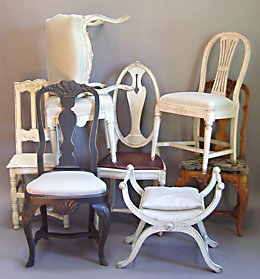+1 413-229-3070 | 800-290-5762 | edithgilson@cupboardsandroses.com
Seating

Antique Seating at Cupboards & Roses
The stool is the first documented piece of furniture, appearing in Egyptian art in 3100 BC. Six hundred years later, a low back was added, and the chair was born. For centuries, the chair was the privilege of rank and nobility, while the rest of society perched on stools. The basic form was enhanced and adapted throughout the Mediterranean until the fall of the Roman Empire.
During the Middle Ages, massive, uncomfortable chairs with architectural form were reserved for figures of authority, both ecclesiastical and temporal. The common folk sat on three-legged stools, on the floor, or on stairs, with or with out cushions. As storage chests became lower, they were also used for seating, giving rise to the bench, and ultimately the sofa. These were first affixed to the wall and later freestanding.
Until the middle of the 17th century, the “master’s” chair, reserved for the head of the family, was generally of oak with a square, flat seat, high back, and arms. The area below the seat was enclosed with panels. In some cases, the seat would be hinged and fastened with a lock and key, and the master literally sat on his assets.
In Northern Europe, the early post chair, similar to the American ladder back form, was preserved in the bride’s dowry chair. This chair had an exaggerated back decorated with open work, chip carving, incising, or paint. These elaborate pieces would be placed on top of the bridal coach when the bride was conducted to her new home and symbolized the important position she would hold in the new family.
By the 1800, chairs were in common use throughout society and had become objects of comfort and beauty. Their design came to reflect the fas hion of the day, and comfort re-emerged as a goal – to create a support for the body that would allow highly relaxed posture.
hion of the day, and comfort re-emerged as a goal – to create a support for the body that would allow highly relaxed posture.
During the 18th century in Sweden, European styles found expression in the more austere Swedish vocabulary. Dutch-style chairs with leather-covered seats and rectangular upholstered backs gave way to more graceful styles from England and France. By mid-century, the Rococo style arrived in seating with gently curving backs and legs, decorated with gesso over wood.
When Gustav III returned from Italy and France, he brought neoclassical sensibilities with him. The curvilinear forms and ornate carvings of the baroque and rococo were replaced with simple forms and tapering legs decorated with reeding, lozenges, egg and dart friezes, bellflowers, and other restrained details.
At the same time, the new tiled stoves made rooms more livable and increased the demand for comfortable armchairs and sofas, such as the new high-armed divan with an upholstered seat and loose back cushions. Loose covers were commonly used to protect fine silk fabrics from sun and soil.
At Cupboards and Roses Antiques, you will find a selection of Swedish chairs and benches in classic forms, ready to be upholstered in your fabrics.